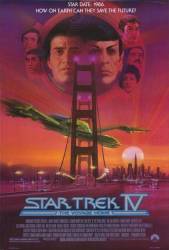Continuity mistake: The Bird of Prey is the one captured by Kirk's crew in ST III. That ship's bridge showed Klingon Cmdr Kruge in his elevated command chair with his helmsmen arrayed circularly below him, and nothing else. ST IV has this same ship; however, the bridge now resembles The Enterprise layout with Kirk's command chair behind Sulu and Chekov at their rectangular helm, with Spock, Scotty, and Uhura at their usual positions.
Suggested correction: According to the captain's log at the beginning, they have been on Vulcan for 3 months. As they prepare to depart, we see several Vulcan technicians moving equipment in and around the ship. It's quite conceivable that the bridge was reconfigured according to the crew's specifications to facilitate their use of the ship. This may seem a bit excessive, as the remodel includes the door onto the bridge, and the frame of the door, and possibly most of the rest of the ship. But it's not outside the realm of possibility. The real mistake, though, is why they would go to the effort of installing new workstations on the Klingon bridge and marking them with Klingon labels, instead of standard Federation text. Interestingly, though, the "Starfleet" style bridge layout of the Klingon ship is being used by the Klingons on the Bird of Prey in Star Trek V.
Factual error: The "whaling boat" is too small to function as such. It isn't large enough to hold a fin, let alone disassemble a humpback whale.
Factual error: At two points in the film, the Klingon vessel Bounty traverses the distance from the Earth to the Sun at maximum speed, in excess of Warp 9. The latter sequence requires about 111 seconds from the time Sulu says "Aye sir, warp speed" until they reach the Sun. While there is no real science behind Star Trek's "warp technology, " the Starfleet Technical Manual provides a formula for calculating warp speed, whereby Warp 9 translates to about 136 MILLION MILES PER SECOND. The Earth is only 93 million miles from the Sun. In the apparent time that it takes the Bounty to reach the Sun, a starship traveling at such ferocious velocity would already be outside of our known solar system and deep into interstellar space.
Revealing mistake: When Chekhov falls on the aircraft carrier a cloud of dust flies up as if he's landed on a mat or soft cargo. When we see him on the floor it's concrete.
Other mistake: When we first see the Klingon bird of prey on Vulcan (just before we see closeups of the "Bounty" written on the side) it is clear that the ship is far too small to contain a pair of adult humpback whales plus 18000 cubic feet of water in its hold. Later, when the ship is hovering above the sea after foiling the whaling ship's attack it seems considerably larger.
Continuity mistake: In the scene where Spock gets confronted after swimming with the whales: you can easily see before he puts on a robe, that his clothes are completely dry, yet he had just been swimming in the shot a moment earlier.
Continuity mistake: The crew wrote 'HMS Bounty' in large red letters on the side of the Klingon Bird of Prey, but in all subsequent flying shots, the large red writing is never seen again. It's not burned off as you only get heat entering the atmosphere if the speed is sufficient, and it's not wind resistance either, because the lettering is missing just after they take off.
Continuity mistake: In the scene with Kirk and Spock walking the marina green under the Golden Gate Bridge, the leading shot shows blue sky. As the camera changes angles, the background changes to completely fogged in. Not shot on the same day.
Factual error: When the Bounty is preparing to slingshot around the sun, the sun is burning a light yellow. From space, it would be white; it only appears yellow when viewed from Earth because of how the visible color spectrum is filtered through the atmosphere.
Plot hole: If the Bird-of-Prey went to warp speed right after the whales were beamed up the ship would have already been so far away from Earth it would have been on its way back towards the sun, yet minutes later the ship is shown leaving the Earth, still at warp speed.
Revealing mistake: When the ship crash lands in the water, and they open the hatch you will see a wall, looks like some piping. When they show the outside of the ship no such wall exists.
Continuity mistake: When we first see the whale pen it is divided from the sea by a concert wall with double gate in the middle, but when the whales are released most of the wall and gates are missing.
Revealing mistake: When Kirk and crew flee the hospital McCoy bumps a man with his leg in a plaster cast. Look closely at the cast - it is fitted over his PJ's leg like a boot, plaster casts are never fitted over clothing.
Factual error: As they descend into the park, Uhura gives a bearing and range of 283 degrees, 15.2 kilometers to the whales, which are supposedly in a marine park in Sausalito. 283 degrees would put you in the Pacific Ocean, because Sausalito bears around 360 degrees from the park. Uhura gives a true bearing to the whales, since a relative bearing would be useless once the crew leaves the park.





